
What do you do when you’re writer-director Jaime Robledo and your play Watson: The Last Great Tale Of The Legendary Sherlock Holmes has won just about every award in the book? Elementary, my dear reader. You do what Sir Arthur Conan Doyle did after creating his mystery-solving supersleuth in A Study In Scarlet (and what Universal Pictures kept doing year after year for their own inimitable Sherlock, Basil Rathbone). You write and direct a sequel, in this case Watson And The Dark Art Of Harry Houdini, and if the results don’t match the original in sheer brilliance, Watson 2.0 does for the most part avoid the dreaded sophomore curse.
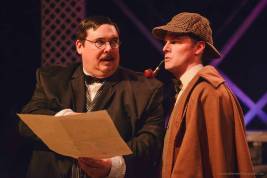 Watson And The Dark Art Of Harry Houdini brings back Scott Leggett’s Dr. John Watson and Joe Fria’s Sherlock Holmes, once again on the tail of a maniacal murderer, this time a serial killer whose many victims’ seven knife wounds each suggest the possibility of multiple perpetrators.
Watson And The Dark Art Of Harry Houdini brings back Scott Leggett’s Dr. John Watson and Joe Fria’s Sherlock Holmes, once again on the tail of a maniacal murderer, this time a serial killer whose many victims’ seven knife wounds each suggest the possibility of multiple perpetrators.
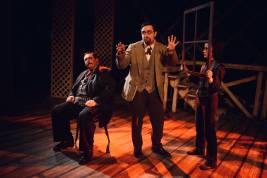 When similar victims begin popping up across the Atlantic, Watson and Holmes travel to America, to Coney Island to be more specific, an amusement park setting that allows director Robledo and his five “Stagehands” to create more of the same kind of cinematic-style magic they did a few years back, and at a tiny fraction of what they’d cost on Hollywood celluloid.
When similar victims begin popping up across the Atlantic, Watson and Holmes travel to America, to Coney Island to be more specific, an amusement park setting that allows director Robledo and his five “Stagehands” to create more of the same kind of cinematic-style magic they did a few years back, and at a tiny fraction of what they’d cost on Hollywood celluloid.
Like Watson: The Last Great Tale Of The Legendary Sherlock Holmes, Watson And The Dark Art Of Harry Houdini flip-flops Sherlock and Dr. W in both importance and style. Whereas Sir Arthur kept a cucumber-cool Sherlock front-and-center and a bumbling Watson in sidekick mode, Sir Jaime casts the good doctor as the smart one and the deerstalker-capped detective as comic relief (though still a master of deduction, as when he solves The Case Of The Mistletoe Murder in a hilarious, fiendishly clever opening sequence).
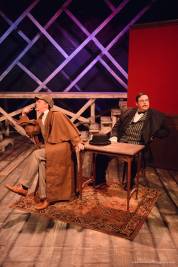 Watson 2.0 reunites our two heroes, estranged these past ten years, during which Dr. Watson has lost his beloved Mary, his grief unabated by the passage of time, a prolonged mourning that darkens Watson (both play and character) this time round and gives Leggett ample opportunity to prove his dramatic mettle.
Watson 2.0 reunites our two heroes, estranged these past ten years, during which Dr. Watson has lost his beloved Mary, his grief unabated by the passage of time, a prolonged mourning that darkens Watson (both play and character) this time round and gives Leggett ample opportunity to prove his dramatic mettle.
Meanwhile, Fria’s Holmes is even wilder-and-crazier than ever, a zaniness considerably more Saturday Night Live than Masterpiece Theatre, and though purists may carp, it’s all part of Robledo’s tables-turning vision, which also includes a wacky Sigmund Freud (Graham Skipper slipping neatly into French Stewart’s shoes this time round).
Understudy Lordan Napoli (as Violet Hunter, the lovely young woman who just might pull John Watson out of his years-long funk) and Watson 1.0 returnees Cj Merriman as a now deceased Mary and Eric Curtis Johnson as Sherlock’s brother Mycroft complete the cast of supporting players.
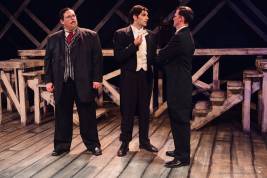 Finally, as its title indicates, Watson And The Dark Art Of Harry Houdini features a third lead character, the legendary real-life illusionist, magician, and “escapologist” Harry Houdini himself, brought to sexy, charismatic life by Donal Thoms-Cappello.
Finally, as its title indicates, Watson And The Dark Art Of Harry Houdini features a third lead character, the legendary real-life illusionist, magician, and “escapologist” Harry Houdini himself, brought to sexy, charismatic life by Donal Thoms-Cappello.
Performances are once again all-around excellent, with a special tip of the hat to the extraordinary Leggett, whose 21st Century American self has vanished beneath Dr. John Watson’s very late-19th Century British skin. In a play that is often comedic, it is Leggett’s dark, brooding Watson that theatergoers will find themselves recalling in the good doctor’s second Sacred Fools outing.
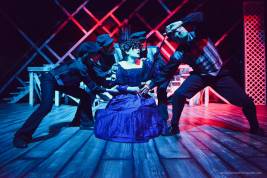 Still, what gives Watson And The Dark Art Of Harry Houdini must-see status are its action set-pieces, the kind that have made Indiana Jones and James Bond perennial screen favorites, accomplished here by a combination of imagination, ingenuity, and the inestimable work of Brendan Broms, Perry Daniel, Aaron Mendelson, Mandi Moss, and Lisa Ann Nicolai as the aforementioned Stagehands.
Still, what gives Watson And The Dark Art Of Harry Houdini must-see status are its action set-pieces, the kind that have made Indiana Jones and James Bond perennial screen favorites, accomplished here by a combination of imagination, ingenuity, and the inestimable work of Brendan Broms, Perry Daniel, Aaron Mendelson, Mandi Moss, and Lisa Ann Nicolai as the aforementioned Stagehands.
I won’t reveal how they do it, but these fantastic five (along with lead and supporting cast members) give us a near-balletic multiple-stab murder, an Orson Wellsian hall-of-mirrors sequence, an ocean liner as it pulls away from the dock, a murder committed in rewind mode, a runaway merry-go-round a la Alfred Hitchcock, a shuffleboard match with flying pucks, a fists-of-fury fight sequence, and a rollicking rollercoaster ride, each one more ooh-and-ahh-worthy than the next.
Most thrilling of all is a one-man Houdini escape so breathtakingly envisioned by Robledo and performed while suspended upside-down from the rafters by Thoms-Cappelo that it will quite literally take your breath away.
Still, Watson And The Dark Art Of Harry Houdini is not without its weaknesses, most notably a storyline that proves (for this reviewer at least) frustratingly abstruse, and that includes the play’s abrupt ending, whose meaning escaped both me and my guest. Also, as has been the case with other Sacred Fools plays developed in weekly installments as part of the company’s smash late-night Serial Killers series, Watson And The Dark Art Of Harry Houdini could stand to lose about one episode’s worth of running time from its talkier scenes.
There can be no carping whatsoever about Robledo’s direction, the cast’s performances, and a design package that’s among the best I’ve seen at Sacred Fools.
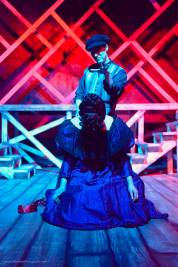 Production designer Michael James Schneider has created an abstract, multi-level set that works particularly well in Coney Island sequences, with Stagehands often becoming part of the scenic design, whether holding windows or filling in for walls. Matt Richter’s lighting design sets precisely the right mysterious, suspenseful mood, as does composer Ryan Johnson’s richly layered original music, aided by Robledo’s sound design. (Much of Watson And The Dark Art Of Harry Houdini is underscored like a movie, and very effectively so.) Linda Muggeridge has designed one gorgeous period costume after another, a bevy of finery no less detailed than those you’d expect to see in a bigger-budged regional production. Andrew Amani once again proves himself a stunt/fight choreographer par excellence, with movement consultant Natasha Norman scoring equally high marks.
Production designer Michael James Schneider has created an abstract, multi-level set that works particularly well in Coney Island sequences, with Stagehands often becoming part of the scenic design, whether holding windows or filling in for walls. Matt Richter’s lighting design sets precisely the right mysterious, suspenseful mood, as does composer Ryan Johnson’s richly layered original music, aided by Robledo’s sound design. (Much of Watson And The Dark Art Of Harry Houdini is underscored like a movie, and very effectively so.) Linda Muggeridge has designed one gorgeous period costume after another, a bevy of finery no less detailed than those you’d expect to see in a bigger-budged regional production. Andrew Amani once again proves himself a stunt/fight choreographer par excellence, with movement consultant Natasha Norman scoring equally high marks.
Watson And The Dark Art Of Harry Houdini is produced by Brian Wallis, Brandon Clark, Laura Napoli and Abraham Benrubi. Monica Greene is assistant director, Aviva Pressman costuming assistant, Fria Suzuki trainer, and Guy Picot dialect coach. Suze Campagna is stage manager and Dana DeRuyck assistant stage manager. The behind-the-scenes team is completed by stage crew Alyson Schultz and costume crew Trey Perkins.
Though not the all-around perfect action-adventure dramedic wonder that was its predecessor, Watson And The Dark Art Of Harry Houdini once again proves a crowd-pleaser, one that makes abundantly clear that with a good deal of imagination, you need but a tiny fraction of what it would cost on the silver screen to make theatrical magic.
Sacred Fools Theater, 660 N. Heliotrope Dr., Hollywood.
www.sacredfools.org
–Steven Stanley
July 7, 2013
Photos: Jessica Sherman Photography
Tags: Dr. Watson, Jaime Robledo, Los Angeles Theater Review, Sacred Fools Theatre, Sherlock Holmes


 Since 2007, Steven Stanley's StageSceneLA.com has spotlighted the best in Southern California theater via reviews, interviews, and its annual StageSceneLA Scenies.
Since 2007, Steven Stanley's StageSceneLA.com has spotlighted the best in Southern California theater via reviews, interviews, and its annual StageSceneLA Scenies.







 COPYRIGHT 2024 STEVEN STANLEY :: DESIGN BY
COPYRIGHT 2024 STEVEN STANLEY :: DESIGN BY